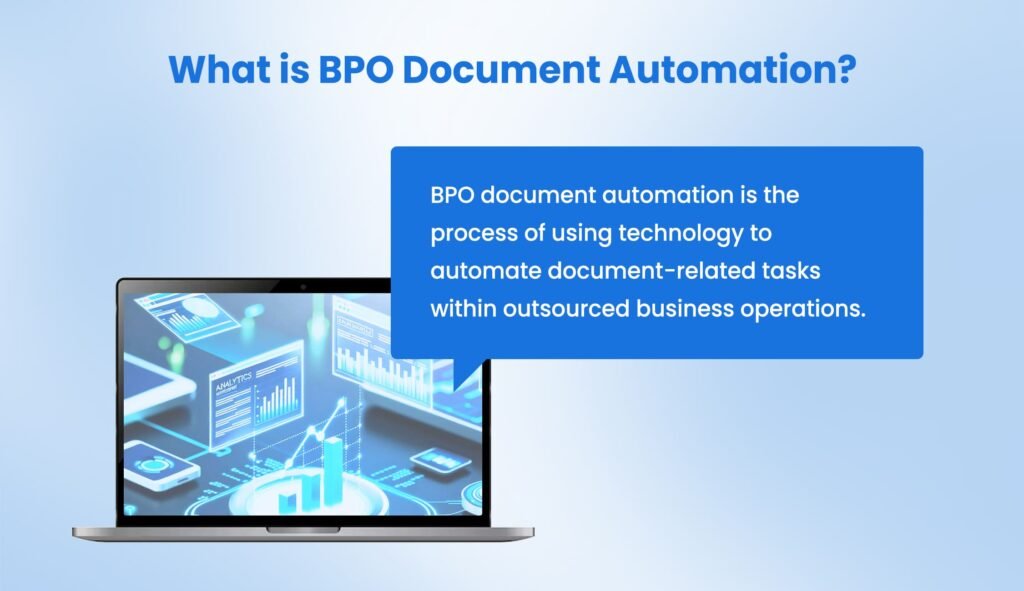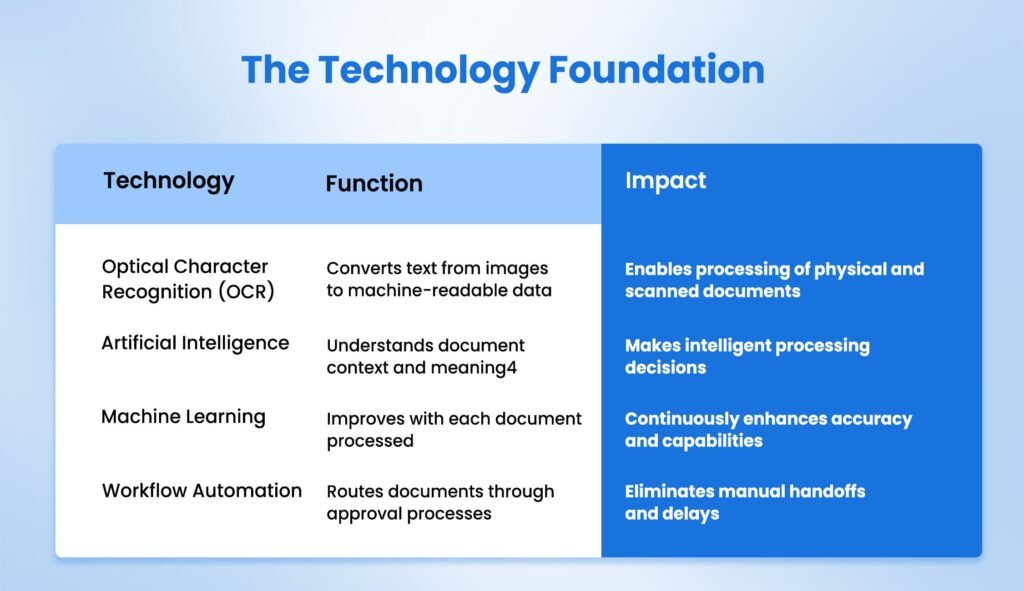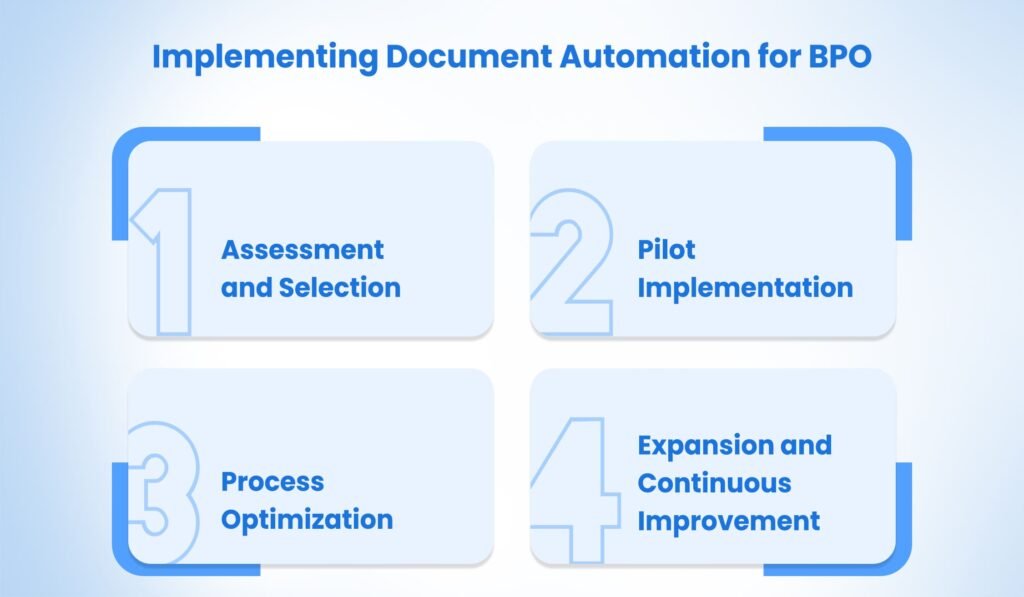What is BPO Document Automation? Benefits, Implementation Guide & Examples

Business process outsourcing (BPO) is a high-demand industry that’s continually evolving. According to Deloitte’s 2023 Global Outsourcing Survey, approximately 70% of BPO firms now rely on automation tools for document handling tasks.
Manual document processing is not just tedious but prone to costly errors, directly affecting efficiency and client satisfaction.
Many organizations are implementing intelligent document processing systems to handle increasing information loads more efficiently.
- How can BPO providers reduce manual labor costs while increasing processing speed?
- Which document-intensive processes deliver the highest ROI when automated?
- What technology innovations are transforming traditional BPO document handling?
Fortunately, BPO document automation makes it easier to streamline operations, reduce costs, and improve accuracy. This powerful combination of outsourcing expertise and cutting-edge technology is transforming how organizations manage information-intensive processes.
Key Takeaways
- BPO document automation combines outsourcing with AI and OCR technologies to process documents with minimal human intervention
- Implementation delivers up to 65% cost reduction while improving accuracy and processing speed
- Key applications include invoice processing, document verification, and customer onboarding
- Success requires selecting the right BPO partner with automation expertise and robust security measures
- Integration with existing systems and creating clear workflows are essential for implementation success
What is BPO Document Automation?

BPO document automation is the process of using technology to automate document-related tasks within outsourced business operations.
It’s a cost-effective method for improving efficiency by using AI and machine learning to reduce manual labor while improving accuracy and speed.
This strategic approach allows BPO providers to focus their human resources on higher-value activities while automating repetitive, rule-based document processing tasks.
“Document automation represents the next frontier for BPO providers seeking to deliver higher value at lower costs. Organizations that master this balance gain a significant competitive advantage.” – Forrester Research
The Technology Foundation
Modern BPO document automation builds upon several integrated technologies:

This technological foundation creates a powerful framework for transforming document-heavy processes in BPO operations.
Primary Benefits of BPO Document Automation
Savvy BPO companies implement automation for various reasons — from boosting productivity without additional hiring to minimizing errors caused by repetitive manual activities. Here’s why leading organizations are investing in document automation:
Increased Efficiency
By automating manual document processes, there’s a massive reduction in processing time. Tasks that once took days are completed in minutes, allowing staff to focus on higher-value activities like customer service and strategic initiatives.
The acceleration comes from eliminating manual data entry bottlenecks, simultaneous processing of multiple documents, and real-time data synchronization across business systems.
Greater Accuracy and Cost Reduction
BPO automation minimizes errors associated with manual labor while ensuring consistent results. Advanced AI and machine learning technologies automate data capture and streamline validation with precision levels that human processing simply cannot match.
The financial impact is substantial:
- Direct labor costs decrease by 40-65% through reduced headcount requirements
- Error correction expenses drop by 80-95% through improved first-pass accuracy
- Document management costs fall by eliminating physical storage and retrieval
- Operational efficiency improves by redirecting staff to value-added activities
A medium-sized BPO operation processing 10,000 documents monthly typically sees ROI within 3-6 months of implementation.
Enhanced Security and Compliance
Manual processes aren’t only inefficient and error-prone — they’re also less secure. Automating BPO document processes increases protection through:
Standardized information handling Document automation applies consistent security protocols across all processing activities, eliminating the variability inherent in manual handling.
Complete audit trails Every document action is recorded with timestamps and user details, creating defensible compliance evidence for regulations like GDPR, HIPAA, and industry-specific requirements.
Automated compliance checking Systems can verify document adherence to regulatory standards in real-time, flagging potential issues before they become violations.

Real-World Applications of BPO Document Automation
Document automation transforms numerous BPO functions. Here are the applications delivering the highest ROI:
Invoice Processing
When a global manufacturing company outsourced their accounts payable processing, they faced a significant challenge. With 15,000 monthly invoices across 12 different formats, their manual processing resulted in 12-day average turnaround times and frequent payment errors.
After implementing intelligent document automation through their BPO partner:
- Processing time decreased to 1.5 days
- Exception rates dropped from 35% to 7%
- Labor costs reduced by 62%
- Early payment discounts increased by $1.2M annually
The transformation went beyond simple cost savings—it fundamentally improved vendor relationships and cash flow management.
Customer Onboarding Without the Waiting
Financial institutions typically struggle with document-heavy customer onboarding. Many banks rely on OCR in banking applications to streamline these processes. A regional bank working with a BPO provider implemented document automation for account opening processes and achieved:
Before Automation:
- 22-minute average processing time per application
- 40% abandonment rate during document verification
- 2.5 days to complete compliance checks
After Automation:
- 3-minute processing time
- 8% abandonment rate
- Same-day compliance verification
- 43% increase in successful onboardings
Data Intelligence Through Document Analysis
Document automation doesn’t just process information — it transforms it into actionable intelligence. BPO providers implementing document classification technologies can now offer advanced analytics services based on document data, helping clients:
- Identify spending patterns across supplier categories
- Optimize payment timing for maximum cash management
- Detect compliance risks before they become problems
- Create predictive models for resource allocation
This evolution from simple processing to data-driven insights represents the future of BPO document automation.
Implementing Document Automation for BPO

Successful BPO document automation requires thoughtful planning and execution. The journey typically follows four distinct phases:
Phase 1: Assessment and Selection
Begin by thoroughly understanding your document ecosystem. Modern BPO providers often implement solutions that can efficiently extract data from PDF files and other document formats.
Document types, volumes, and processing requirements form the foundation of your automation strategy.
Critical questions to answer:
- Which document processes consume the most resources?
- Where do errors and bottlenecks most frequently occur?
- What integration requirements exist with current systems?
- Which security and compliance standards must be maintained?
Based on these answers, evaluate potential BPO partners with document automation expertise. Look beyond general capabilities to industry-specific experience and proven implementation methodologies.
Phase 2: Pilot Implementation
Start with a controlled implementation focusing on high-volume, standardized document types. Many organizations begin with shipping documents like ocean bills of lading or standard financial forms. This approach allows for:
Testing integration points without disrupting critical operations
Refining exception handling processes before full deployment
Demonstrating ROI to secure buy-in for broader implementation
Training staff on new workflows in a controlled environment
A pilot typically runs 4-6 weeks and processes a representative document sample, providing valuable performance data.
Phase 3: Process Optimization
With pilot results in hand, refine the automation approach:
WORKFLOW REFINEMENT PROCESS
- Analyze exception patterns to identify improvement opportunities
- Adjust extraction templates based on document variations
- Fine-tune approval routing based on business rules
- Optimize integration points with downstream systems
- Document standard operating procedures for consistent execution
This iterative refinement typically yields a 15-20% performance improvement before full-scale deployment.
Phase 4: Expansion and Continuous Improvement
With core processes running efficiently, expand automation to additional document types and processes. Establish performance metrics and regular review cycles to identify further optimization opportunities.
The most successful implementations create a continuous improvement feedback loop where:
- Performance data drives enhancement priorities
- User feedback identifies friction points
- Technology updates are incorporated systematically
- Process optimizations are tested and deployed regularly

Overcoming Implementation Challenges of BPO Document Automation
The path to successful BPO document automation isn’t without obstacles. Understanding common challenges helps organizations navigate them effectively.
The Human Element: Training and Adaptation
Technology adoption demands new skills from your team. BPO staff accustomed to manual document handling need comprehensive training to become automation specialists. Organizations using technologies like data parsing need to ensure their teams understand the technical aspects while maintaining business context.
Successful organizations address this through:
- Comprehensive training programs that build both technical and process knowledge
- Clear communication about how roles will evolve rather than disappear
- Recognition systems that reward adaptation and innovation
- Involvement of staff in workflow design to leverage their operational expertise
Security in an Automated Environment
Document automation in BPO environments introduces unique security considerations. When implementing your solution, consider these critical factors:
| Security Dimension | Implementation Requirement |
| Data Transmission | End-to-end encryption for all document transfers |
| Processing Security | Secure extraction environments with access controls |
| Storage Protection | Encrypted repositories with defined retention policies |
| Compliance Framework | Industry-specific security protocols (HIPAA, GDPR, etc.) |
Integration: The Technical Challenge
Legacy systems rarely communicate effortlessly with modern automation platforms. Advanced BPO providers leverage specialized document processing techniques to overcome these integration challenges, which typically arise from:
API Limitations
Older systems often lack modern integration capabilities
Data Format Inconsistencies
Varying standards create transformation challenges
Custom Workflows
Bespoke processes resist standardization
Security Requirements
Cross-system authentication creates complexity
Successful implementations typically employ middleware solutions or integration platforms that bridge these gaps without requiring substantial changes to existing systems.
Why Should You Choose KlearStack for BPO Document Automation?
Document-intensive operations need intelligent automation solutions. Your current systems may struggle with varied formats and complex data extraction needs. KlearStack transforms how organizations handle BPO document processing by combining cutting-edge AI with practical business solutions.
Solutions That Matter:
Template-free processing that handles any document format without pre-configuration. Self-learning AI that continually improves with each processed document. End-to-end automation reducing manual intervention by up to 80%.
Proven Performance in BPO Environments
Processing Speed: Handle 10,000+ documents daily with consistent accuracy and throughput
Multi-Format Support: Process invoices, contracts, forms, and unstructured documents without template training
Accuracy Guarantee: Achieve 99% extraction accuracy across all document types
Your BPO document operations need intelligent technology that improves over time. KlearStack’s system learns from each document it processes, continuously enhancing extraction accuracy and reducing exception rates.
Key BPO Processing Capabilities:
- Intelligent field extraction from complex and varying layouts
- Automated data validation with cross-reference verification
- Secure document handling meeting banking and healthcare standards
- Seamless integration with existing ERP, CRM, and accounting systems

Get More Done in Less Time
BPO document automation represents a transformative approach to handling information-intensive processes. By combining the flexibility of outsourcing with powerful automation technology, businesses can achieve remarkable improvements in efficiency, accuracy, and cost control.
Automation is essential for streamlining document operations like invoice processing, customer onboarding, and data extraction. By automating repetitive manual tasks, BPO providers can free up their employees’ time for higher-value work while reducing errors and increasing accuracy.
The implementation challenges shouldn’t deter organizations from embracing technology’s ability to improve operational effectiveness and lower overhead costs. The future of BPO lies in this intelligent combination of human judgment and automation technology.
FAQs on BPO Document Automation
The difference is that BPO outsources business functions, while document automation processes documents with minimal human input. BPO document automation combines both approaches for enhanced efficiency.
Companies implementing BPO document automation typically save 40-65% on processing costs. ROI generally appears within 3-6 months through reduced labor, fewer errors, and faster processing.
The documents that work best are high-volume, standardized formats like invoices and purchase orders. Modern AI systems can also effectively handle semi-structured documents such as contracts.
BPO document automation can be implemented in 2-3 weeks for standard document types. More complex workflows may require 4-8 weeks, with templates accelerating deployment.


